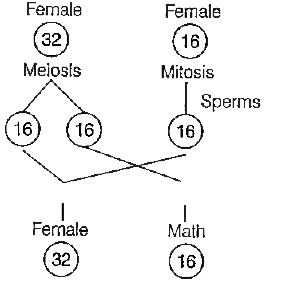Answers any two questions (restrict each answer within 200 words):
What do you understand by sex-determination? Describe sex-determination in honeybee.Solution in Odia
The establishment of sex through differential development in an individual at the time of zygote formation is termed as sex-determination.
The chromosomes are responsible for the sex-determination in many organisms. The chromosomes controlling the sex are called sex-chromosomes and the remaining chromosomes controlling the normal metabolism are known as autosomes.
The organisms may either be male or female depending upon the sex organs. There are various mechanisms of sex-determination in different groups of organism.
Sex-determination in honeybee In honeybees, sex is normally determined by the fertilisation or non-fertilisation of eggs, rather than the presence or absence of sex chromosome in them. The drones (males) are entirely derived from unfertilised eggs laid by the queen, i.e. their mother. The diploid queen has 32 chromosomes and the haploid drone has 16 chromosomes. Drones produce sperm cells that contain their entire genome. The genetic make up of male bees is therefore, entirely derived from the mother. While the genetic make up of feffiale worker bees is half derived from the mother and half from the father.
Queen bee picks up all the sperms from the drone during nuptial flight and stores the same in her seminal vesicle. Formation of worker bees (diploid females) and drone (haploid males) depends upon the brood cells visited by the queen. While visiting the smaller brood cells, the queen emits sperm from its seminal receptacle after laying the eggs. As it visits the larger brood cells, it continuously lays.

the eggs but the seminal receptacles fail to emit the sperms due to some sort of pressure on the ducts coming out of them. When a queen is to be formed, the workers enlarge one of a small brood cells having fertilised egg and feed the emerging larva on a rich diet.
Males are normally fertile haploids due to development from unfertilised eggs. Occasionally, diploid infertile males are also produced from heterozygous females through fertilisation.
Topper's Solved these Questions
- VERY SIMILAR TEST 5BOOK - ARIHANT PRAKASHANCHAPTER - VERY SIMILAR TEST 5EXERCISE - SECTION B (ZOOLOGY) GROUP B
9 Videos
- VERY SIMILAR TEST 4BOOK - ARIHANT PRAKASHANCHAPTER - VERY SIMILAR TEST 4EXERCISE - SECTION B (ZOOLOGY) (GROUP C)
4 Videos
- VERY SIMILAR TEST 7BOOK - ARIHANT PRAKASHANCHAPTER - VERY SIMILAR TEST 7EXERCISE - Section B (ZOOLOGY) (Group C)
7 Videos
Similar Questions
Answer any three of the following (restrict each answer to two or three important Sentences):
(a) What may be the possible effects of indiscriminate use of steroids and analgesics to the body?
View SolutionAnswer any two questions (restrict each answer within 200 words):
Write short notes on any two of the following:
(a) Menopause
(b) Parturition
(c) Types of sex-linked genes
(d) Codominance
View SolutionWrite notes on :
View SolutionThe sex determination pattern in honeybee is called
View SolutionExplain the mode of sex determination in honeybees.
View SolutionExplain the mode of sex determination in honeybees.
View SolutionWhat is sex chromosome? Give the method of sex determination in honeybee.
View SolutionState how sex is determined in honeybees.
View SolutionExplain the process of sex determination in honeybees.
View SolutionQuestion|Sex Determination|XX-XO Type|ZZ-ZW Type|XX-XY Type|Sex Determination In Humans|Sex Determination In Honeybee
View SolutionAnswer any two questions (restrict each answer within 200 words): Write short notes on any two of the following: (a) Menopause (b) Parturition (c) Types of sex-linked genes (d) Codominance
View SolutionAnswer any two questions (restrict each answer within 200 words): Describe the embryological evidences of organic evolution.
View SolutionAnswer any two questions (restrict each answer within 200 words): Describe the structure of a mature human sperm with the help of a well-labelled diagram.
View SolutionAnswers any two questions (restrict each answer within 200 words):
Write notes on any two of the following:
(a) Founder effect
View SolutionAnswers any two questions (restrict each answer within 200 words): Write notes on any two of the following: (b) Gynandromorph
View Solution
